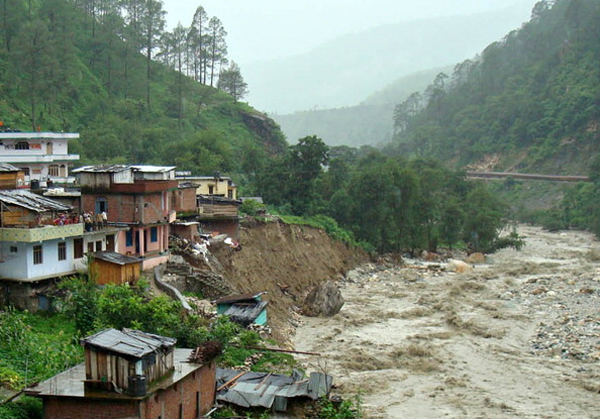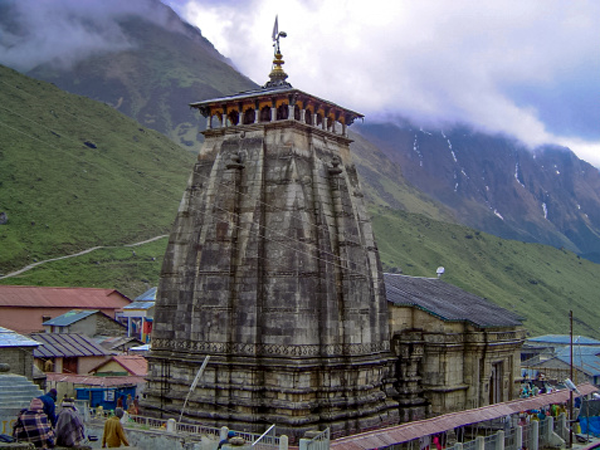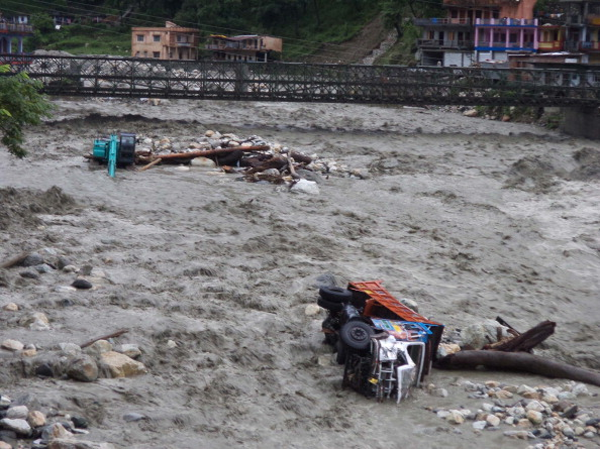Apr 19, 2024
Apr 19, 2024

The holy shrine Kedarnath is very much in the news. It witnessed one of the worst natural disasters in the recent years. On the morning of 16th June, 2013, as per the newspaper reports, there was a loud explosion in the Gandhi Sarovar, about four km upstream from Kedarnath. Thereafter a huge mass of rocks and mud and water began engulfing the whole valley. The mudslide was so powerful, that it did not spare anything in its wake.

It is not that, that Kedarnath had not witnessed natural calamities in the past! Between 14th century and 17th century, the shrine and the valley were completely covered with ice for four hundred long years. After the mini-ice age was over, the temple re-emerged unscathed but for the striations left by the retreating ice. These were the clues for the geologists to work out the direction of movement and the weight of the Ice etc. later. Similarly, the temple, since its construction, couple of thousand years ago has stood like a light house against devastating earthquakes that have visited the young, high rise mountains.
Situated at an altitude of 3600 m. above mean sea level, in the Mandakini River valley which runs almost north-south, bound by five peaks, viz., 5505m peak, Bharat Kunta peak-6578m, Kedarnath peak-6940m, Mahalaya Paravat peak-5970m and Hanuman top peak-5320m. These form a sort of amphitheatre called as a cirque in the lingua of the glaciologists. A 5040m triangular peak, the Brahma Gupha juts out majestically in the middle of the cirque. The width of the valley in the cirque area (valley head) is six kilometer and narrows down to three kilometer in the southern end.

Deepak Srivastava, an eminent Glaciologist of Geological Survey Of India, had worked in Kedarnath Valley to study the possibility of avalanches and consequences thereof. Srivastava in one of his papers says that the Mandakini River valley is unique because two glaciers that have separate regimen, orientation and flow occupy this single valley. The two glaciers, Chaurabari and Companion glaciers terminate at different elevations, at the same place. From the moraines it appears that these two glaciers were unified in the past and occupied the entire one kilometer wide valley at Kedarnath. Moraines are the rock boulders of assorted sizes to rock flour produced and carried by the glacier and left behind as they recede. These moraines are well established and held at place by the vegetation for a length of three kilometers up to the snout of the glaciers. The moraines have lots of stories hidden in them. It appears that there were at least four major episodes of glacier recession as marked by the traces of the moraines throughout the valley. In other words, earlier the glaciers had descended down to much lower levels than the present.
Kedarnath Township is situated on a glacial outwash plain. Channels of Mandakini River originate from Chaurabari and Companion glaciers and encircle this plain to meet below the township. The erosion by the stream has been such that it has cut through the water table in the upper part of the plain. Thus constant oozing of water has made the place marshy.
Altogether 28 probable avalanche zones have been identified by Srivastava and his team mates situated between altitudes of 3800 to 4000 meters. One of them designated as R-13 has an average ice volume of 70891m3 with a chute length of 900m and impact force of 84.8tonnes/m3. Here it worth knowing that while an impact force of 10tonnes/m3 can uproot matured trees, an avalanche of 100tonnes/m3 can move reinforced concrete structures. Therefore the planners must always remember that there is no engineering solution against geohazards.
The temple has been safe from avalanches through the centuries. Even the present township of Kedarnath has not been hit by a major avalanche. An acute need for further expansion is being felt. For which the terraces on the left side only, up to Lenchuri village have been recommended by the glaciologists of GSI. Only drawback of this portion is the marshy condition due to deep erosion of the terrace. Development of a proper drainage can take care of the condition and habitats can be safely constructed.
The avalanche prone area is prone to landslides as well. The varying size of lose rock material, right from rock flour to giant boulders, makes this admixture a potent tool to wipe out anything coming in its path, if it decides to move. The marshy terrace, release of water from the Gandhi sarovar due to release of a possible blockade and incessant rains from skies, all must have abetted in the movement of this mass down the slope.
The builders of Kedarnath temple were no engineers, but they had common sense. They chose a spot between the two branches of Mandakini, which was safe from avalanches and was slightly higher than the surrounding country. The structural design of the temple was such that it withstood large earthquakes which visited the area in the past 1000 years. Similarly, it withstood the mass of ice which covered it for 400 years between 13th and 17th century.
Alas, the human greed overcame the sanctity of the valley and the passage of water was choked by the rampant construction, obviously to make a quick buck from the pilgrims. This led to the tragedy.
What has happened cannot be undone. But if the pilgrimage has to continue in the future, the Uttarakhand Government must consider a reassessment of the ground bearing capacity of the valley to allow only essential construction activity, provide proper drainage and think of regulating the number of visitors per day.
Continued to Why Uttarakhand is Crumbling!
Images (c) Gettyimages.com
20-Jun-2013
More by : V. K. Joshi (Bijji)

|
@ Surabhi-thanks. @ Srikantia sb.-The jhoola bridge at Dharcha is vividly entrenched in my memory too. There was a paper published in Current Science some three or four years ago. I will locate the exact ref and get back to you. The author in the paper had identified the glacial striations on the surface of rocks forming the walls of the temple and also done some carbon dating of wood used in the temple and neighbouring areas. The effects of age are catching up and references become problem to remember. I had published that story in one of my articles here in boloji.com. @ Thanks neelam. @ Thanks Ashok. I will certainly read your story. |

|
Excellent eye opener. a clinical survey that gives appropriate insight into the folly by locals and the government. instead of condemning, its more informative. Hope officials and political big-wigs take appropriate preventive and corrective measures before allowing mushrooming of man-made structures, to avoid or atleast cut down the loss of human and animal life. |

|
Many new details about the geology of the area has been summed up well. I have tried to analyze what could have happened in Kedarnath. The whole Kedarnath Temple area is covered with 9 to 10 feet of silt from the landslide flash floods. Check out my analysis about "Nature’s Fury In Uttarakhand – Devastation Beyond Comprehension" http://www.gujaratweather.com/wordpress/?p=4240 |

|
Thanks Akhilesh. Per main aapo ashwast karna chahta hu ki Tehri nahi tootega-woh tabhi tootega jab pralay hoga-us din to main aur aap comment karney ko bhi nahi bach payengey.Per jagrookta is baat ki hai ki log anaapshnaap nirmaan na kareyn. Isi boloji mein mera ek lekh hai damned by a dam-mera sujhaav hai ki aap usey avashya padhey. |

|
Thanks Shiv. I am glad that you liked it. I dont know whether Modi or which leader will deliver the goods. But I am certain that if people, the residents understand the facts narrated in my article and begin to think of their future, they will stop illegal constructions. |

|
Vijai, you write so well it is a pleasure going through the same. You have given useful information and correctly highlighted the wisdom of our ancient builders in choosing a high island in between two branches of the Mandakini. These are eco-sensitive areas which should be free from construction activity. We should have regulated tourism. We have no record of the volume of daily flow of water in the Mandakini river during monsoon season. According to reports available, the devastation is mainly due to cloudburst and flash flood which brought along with it huge volume of debris and fallen boulders with great energy. The construction activity must have tinkered with the drainage system. You have also said the same thing. In about two months they will forget about the calamity, only those who have lost their kith and kin will continue to mourn. Greed is the only focus and the partners are politicians, authorities, business, timber and mining mafia and spineless bureaucrats. Govt should construct a chain of Jhoola crossings which help those trapped to use them in such situations. At the start of Zanskar expedition, when the bridge at Darcha had been washed away only a Jhoola constructed post haste enabled us to cross the river and transport nearly two truck load of camp equipment etc. I recollect my own experience near Barashigri glacier. What is the source of your information that the Kedarnath area was covered under ice for 400 years? That is unusual during the period of 13th and 17th century. |

|
our politicians do not listen to the predictions by geologist every one wants to live in those beautiful places if we make our way in rivers course thn it will happen again and again |

|
Ye mamuli jheel ka ufan tha. Tihari toota to kya hoga. Ab isper jagrukta ki jaroorat hai. [Indian Journalists Group: Linkedin] |

|
Excellent report though some part of it is way over my limited knowledge and comprehension.This report probably gave a snap shot of what must have happened, why it must have happened, the scale of disaster and that there is enough knowledge base within our country to address.The time has come for people to say enough of the non sense of this unbridled greed and mayhem caused by crooks who have found refuge in political parties.It is time to chuck the sonias and even jellybeans of confused politicians of advani breed. We need a new India lead by honest men/women who are not swayed by many lollipops thrown their way.At least Modi will be a start, once we elect him, we must start the process of bringing new order ,look past Modi with better caliber men/women to lead this nation. |